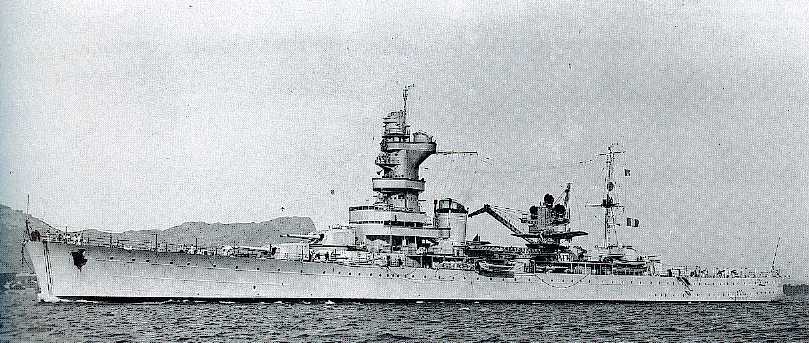Nearly identical to the previous 203 mm/50 (8") Model 1924 except for the longer bore. These guns were used only on the heavy cruiser Algérie. It is believed that these guns were made partly from components of the old 240 mm/50 (9.45") Model 1902-06 guns.
Actual bore diameter was 20.30 cm (7.992").
A Note on Sources: John Campbell in his "Naval Weapons of World War Two" published in 1985 states that Algérie was armed with a new gun, the 203 mm/55 Mle 1931. Many French and English references both newer and older disagree and state that Algérie used the same 50 caliber gun as did the earlier French 203 mm cruisers. However, John Jordan has recently (December 2024) informed me that he has found what he terms "compelling evidence" that Campbell was correct and that she was indeed armed with a new 55 caliber gun. Mr. Jordan will be formally publishing his findings in "Warship 2026."
| Designation | 203 mm/55 (8") Model 1931 |
|---|---|
| Ship Class Used On | Algérie |
| Date Of Design | 1931 |
| Date In Service | 1933 |
| Gun Weight | 21.69 tons (22.04 mt) |
| Gun Length oa | 458.7 in (11.650 m) |
| Bore Length | 444.9 in (11.300 m) |
| Rifling Length | 365.0 in (9.272 m) |
| Grooves | N/A |
| Lands | N/A |
| Twist | N/A |
| Chamber Volume | 5,595 in3 (91.682 dm3) |
| Rate Of Fire | 4 - 5 rounds per minute 1 |
- ^Planned rate of fire for cruisers was 5 - 6 rounds per minute, but in practice it was closer to the above values.
| Type | Bag |
|---|---|
| Projectile Types and Weights 1a 2a 3a | APC M1931(?) 4a: 262.5 lbs. (119.07 kg)
APC M1936 5a: 295.4 lbs. (134.0 kg) HE M1931(?) 4a: 263.94 lbs. (119.72 kg) |
| Bursting Charge | APC M1931(?): about 8.4 lbs. (3.81 kg) Mélinite
APC M1936: about 9.7 lbs. (4.4 kg) Mn.F.Dn HE M1931(?): about 17.6 lbs. (8.0 kg) Mélinite |
| Projectile Length | APC M1931(?) and HE M1931(?): 39.6 in (100.5 cm)
APC M1936: 38.6 in (98 cm) |
| Propellant Charge | Full Charge: 102.0 lbs. (46.4 kg) BM 15D2 (410 x 42 x 3) 6a |
| Muzzle Velocity | APC M1931(?) and HE M1931(?): about 2,850 fps (870 mps)
APC 1936: about 2,760 fps (840 mps) |
| Working Pressure | APC M1931(?) and HE M1931(?): about 18.0 tons/in2 (2,8000 kg/cm2)
APC M1936: about 19.0 tons/in2 (3,000 kg/cm2) |
| Approximate Barrel Life | about 600 rounds |
| Ammunition stowage per gun | Cruisers: 150 rounds 7a Surcouf: 300 rounds |
- ^
Actual French designations APC M1931(?) OPf Mle 1931(?) APC M1936 OPf(K) RC Mle 1936 HE M1931(?) OEA Mle 1931(?) - ^As in many French weapons, there were multiple variations of both the OPf and OEA projectiles in the 1931(?) Model Year. This was primarily due to which sort of fuze was used in them, such as instantaneous or delay types.
- ^These projectiles were also issued to the older cruisers armed with the 203 mm/50 (8") Model 1924 guns.
- ^APC M1936 and possibly some of the older shell types had a dye bag added after March 1939. It is not known what color was assigned to Algérie.
- ^The propellant charge was in halves. Each cartridge used a 1.65 lbs. (0.750 kg) black powder igniter. The igniter weight, propellant weight and propellant type shown above are taken from a German drawing of the cartridge. This cartridge may also been used for the older 203 mm M1924 guns. See sketch below.
- ^At least the Suffren class and probably the others had a peacetime outfit of 120 rounds per gun but had enough magazine space for 150 rounds per gun.
| Elevation | APC M1931(?) and HE M1931(?) @ MV = about 2,850 fps (870 mps) | APC M1936 @ MV = about 2,760 fps (840 mps) |
|---|---|---|
| 45 degrees | about 35,350 yards (32,500 m) | about 33,000 yards (31,000 m) |
| Designation | Two-gun Turret
Algérie (4): Model 1931 1b 2b Three-gun Turret
|
|---|---|
| Weight 4b | about 220 tons (240 mt) |
| Elevation | -5 / +45 degrees |
| Elevation Rate | about 10 degrees per second |
| Train | about +90 / -90 degrees |
| Train Rate | 6 degrees per second |
| Gun recoil | about 27.5 in (70 cm) |
| Loading Angle | -5 / +10 degrees |
- ^These mountings were similar to the earlier M1924 mountings but had more powerful training motors to handle the increased armor weight. The guns used catapult rammers cocked by the recoil forces to load projectiles while propellant charges were loaded by hand. Guns were individually sleeved. Dredger hoists from the magazines ran up to a working chamber where ammunition was transferred to the upper cage hoists which each carried a projectile and two half charges. Upper hoists ended on the outside of the guns and the projectiles were transferred by swinging arms which were locked to the guns for loading. RPC for training was added during the 1930s.
- ^Gun axes were 74 in (188 cm) apart.
- ^In 1939 the French started designing new cruisers that were intended to replace the Duguay-Trouin class. The preliminary design was known as "C5" and was for a 10,000 ton Treaty Cruiser similar to Algérie but having nine 203 mm (8") guns in three turrets. The start of the war ended all treaty restrictions and in early 1940 a more ambitious nine-gun design known as "St. Louis" was under consideration. Little more than some preliminary sketches for a ship of around 15,000 tons were completed before the June 1940 Armistice halted all work.
- ^Armor thickness of the Model 1931 turrets from "French Cruisers: 1922 - 1956" as follows:
Model 1931 - Algérie Front 3.9 in (10 cm) Sides 2.8 in (7 cm) Roof 2.8 in (7 cm) Rear 1.96 - 3.3 in (5 - 8.5 cm) Floor 1.6 in (4 cm)



"Warship Volume VII" article by Francis J. Allen
"Naval Weapons of World War Two" by John Campbell
"French Cruisers: 1922 - 1956" by John Jordan and Jean Moulin
"Navies of the Second World War - The French Navy" by Henri le Masson
"Cruisers of World War Two" by M.J. Whitley
---
Ministère de la défense
---
Special help from Zhu Shipeng and Email conversations with John Jordan of 14 February 2022 and 10-17 December 2024
07 October 2006 - Benchmark
03 March 2012 - Updated to latest template
17 December 2024 - Reworked to match latest data on 55 caliber gun vs. 50 caliber gun

